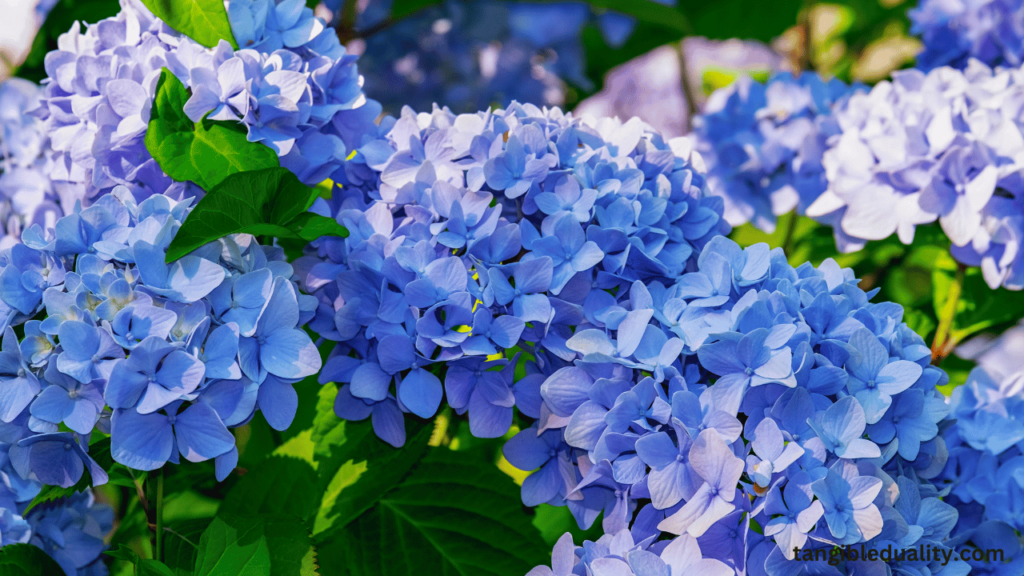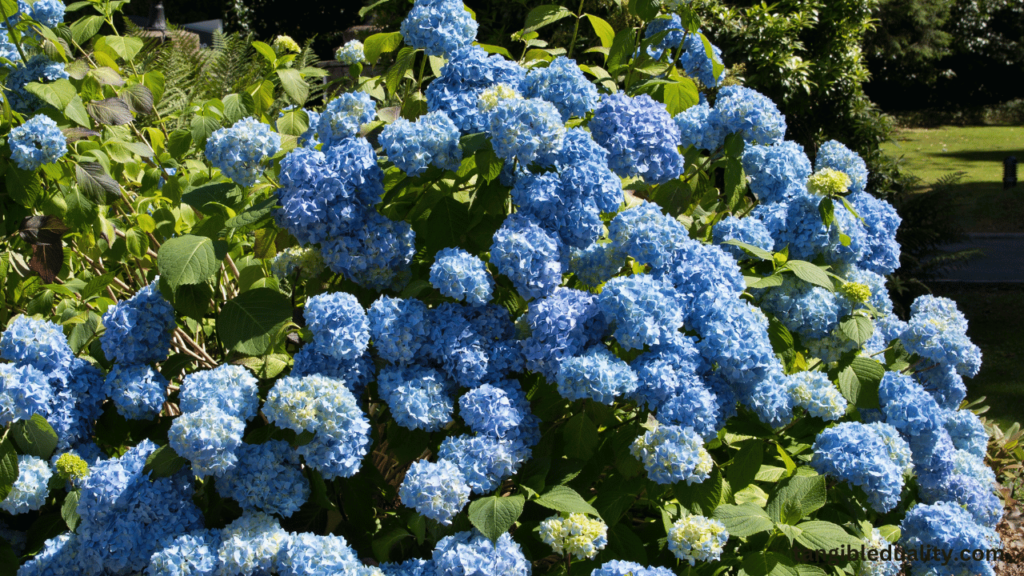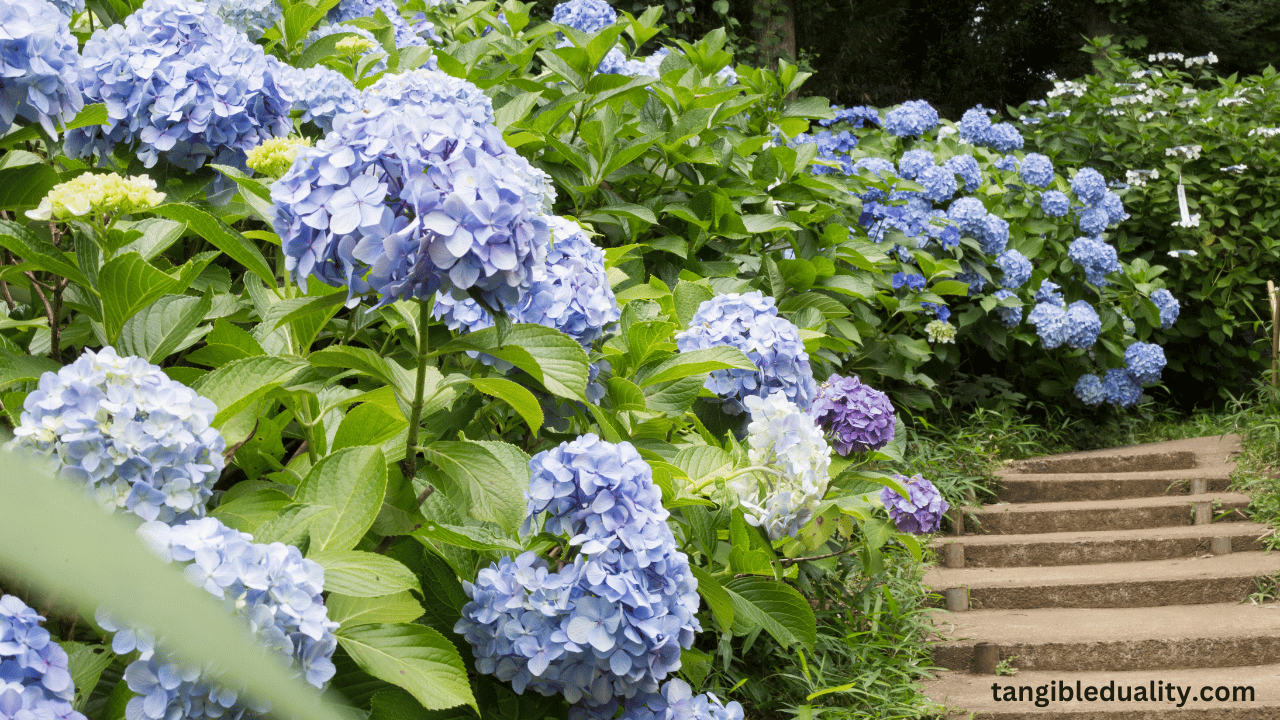Since ancient times, gardeners and people who are passionate about plants have been captivated by the awe-inspiring flowers of hydrangeas. These blooms come in a wide spectrum of beautiful colors, from bright pinks to deep blues.
In spite of the fact that their delicate beauty is sufficient to complement any garden, attaining those coveted blue hydrangea flowers can be a challenging but ultimately gratifying endeavor. It is difficult to imagine anyone who would not wish to turn their yard into a magical haven of blue hues.
In this piece, we will investigate the mysteries behind the process of turning hydrangeas blue, as well as uncover the natural and efficient methods that may be utilized to attain the desired color.

Understanding Hydrangea Color
Before we delve into the process of making hydrangeas blue, it’s crucial to understand the science behind their coloration.
The color of hydrangea blooms is determined by the relative acidity or alkalinity, commonly known as pH, of the soil in which they are grown. In alkaline soil (pH above 7), hydrangeas tend to produce pink or red blooms.
Whereas acidic soil (pH below 7) showcases vibrant blue shades. The presence of aluminum in the soil also plays a significant role in hydrangea coloration.
Amending Soil pH for Blue Hydrangeas
To achieve blue hydrangea blooms, it is necessary to adjust the pH of the soil to make it more acidic. Here are some natural amendments you can use to influence the soil pH:
- Coffee Grounds: Coffee grounds are rich in acid and can be mixed into the soil around hydrangea plants to increase their acidity gradually. However, it is essential to use them sparingly, as excess coffee grounds may lead to imbalances in the soil.
- Pine Needles: Abundantly available in forests, pine needles act as a natural acidifier when used as mulch around hydrangeas. They slowly release acids into the soil, helping create an environment conducive to blue hydrangea coloration.
- Elemental Sulfur: Elemental sulfur is a powerful soil acidifier that can be applied to the soil to decrease pH levels over time. The recommended application rates must be carefully followed to avoid harming plants or the surrounding ecosystem.
- Peat Moss: Adding peat moss to the soil enhances its acidity while also improving moisture retention. It is advisable to mix peat moss thoroughly with the existing soil before planting hydrangeas.
- Vinegar: Diluted white vinegar can be used sparingly to increase soil acidity. However, it is vital to exercise caution when using vinegar, as excessive amounts may harm plants and adjacent soil.

The Role of Aluminum
Apart from soil pH, the presence of aluminum also plays a significant role in determining the blue color of hydrangea blooms. When the soil is sufficiently acidic, aluminum becomes available for uptake by the plant’s roots. Here are a few natural ways to enhance aluminum availability:
- Aluminum Sulfate: This amendment can increase the availability of aluminum in the soil. It is recommended to use it sparingly, following the instructions provided, to prevent excessive aluminum accumulation, which can be harmful to plants.
- Composted Oak Leaves: Oak leaves are known to contain high levels of aluminum. By composting them and incorporating the compost into the soil around hydrangeas, the aluminum content can be gradually increased.
Maintaining Optimal Conditions
Once the necessary soil amendments have been made, it is important to maintain the optimal conditions for blue hydrangeas.
- Adequate Watering: Hydrangeas prefer moist soil but cannot tolerate excessive waterlogging. Water them regularly, ensuring the soil is consistently damp but well-drained.
- Mulching: Applying organic mulch, such as bark chips or shredded leaves, around hydrangeas helps retain soil moisture and prevent the growth of competitive weeds.
- Regular Testing: Periodically test the soil’s pH using a soil testing kit to ensure it remains within the desired acidic range for blue hydrangea coloration.
Conclusion
It is possible to accomplish the task of transforming your hydrangeas into a sea of stunning blue petals if you have the appropriate information and techniques that are natural.
It is possible to modify the composition of your soil in order to create the ideal habitat for blue hydrangea colors if you have an understanding of the impact that soil pH and the availability of aluminum, respectively, have.
Keep in mind that the improvements may not appear immediately, so be patient and diligent in your efforts. If you provide your hydrangeas with constant care and maintenance, you will be able to watch their stunning transformation.
They will fill your garden with a brilliant palette of blues that will definitely fascinate anyone who comes into visual contact with them.
FAQs
Q: Can I make hydrangeas blue instantly?
A: Unfortunately, achieving blue hydrangea blooms is a gradual process that requires making amendments to the soil and allowing the plant to take up the necessary elements over time. It may take a year or more to see significant color changes.
Q: Will using too much aluminum sulfate harm my hydrangeas?
A: Yes, excessive use of aluminum sulfate can harm hydrangeas and other plants. It is crucial to follow the recommended application rates to avoid overloading the soil with aluminum, which can lead to toxicity.
Q: Can I change the color of hydrangeas that are already established?
A: Changing the color of established hydrangeas can be challenging, as their color is influenced by various factors, including genetics. It is easier to alter the color of younger plants or those that have not yet bloomed.
Q: Are there other factors that affect hydrangea color?
A: Yes, apart from soil pH and aluminum availability, the specific hydrangea variety also plays a role in determining the color of the blooms. Different cultivars have different levels of pigments and may display variations in color responses to soil amendments.
Q: Can I control the color of hydrangea blooms in containers?
A: Yes, you can control the color of hydrangea blooms in containers by carefully selecting the potting soil and incorporating acidifiers like coffee grounds, pine needles, or sulfur. Remember to monitor the soil pH regularly and adjust as needed to maintain the desired color.

